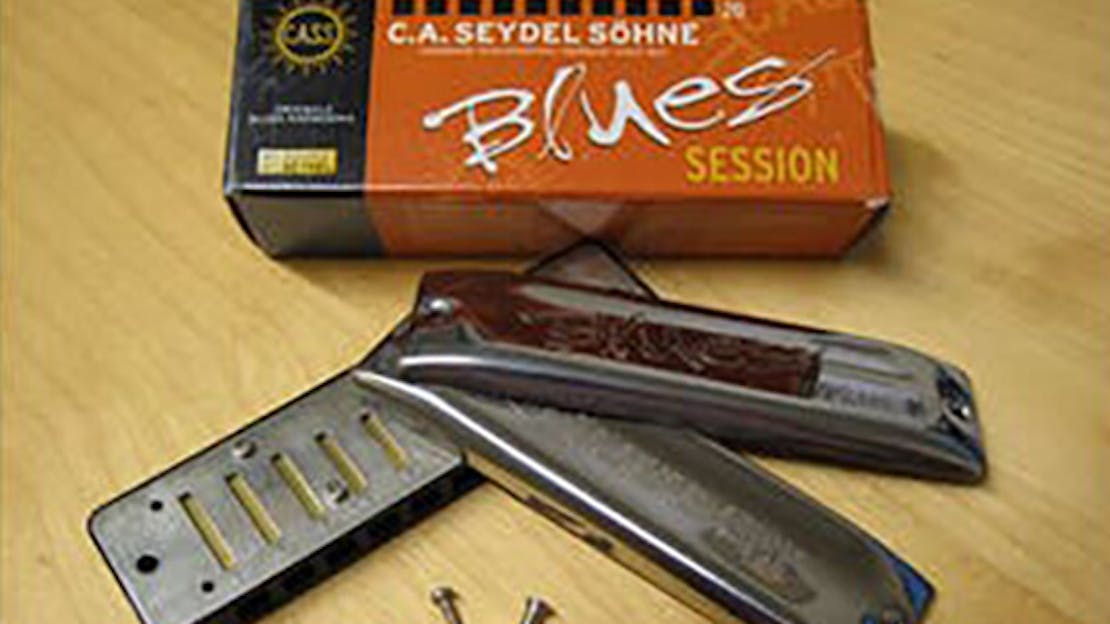
Anatomy of the Harmonica
A harmonica is an assembly of a number of parts. In this section Eagle Music explains the major parts of a harmonica all simplified and explained in clear detail.
A harmonica is an assembly of a number of parts. Harmonica parts have to be fitted together correctly and precisely assembled to make the instrument ‘airtight’ and playable. The major parts of a harmonica are simplified here and explained in detail as follows; The Comb, Cover Plates, Mouthpiece, Reeds, Reed Plates, Rivetting, Slider Mechanism, Valves / Windsavers etc. The descriptions below are written in alphabetical order.
Comb
A harmonica is built around what is called a COMB. The comb is the central part of a harmonica. The comb can be made of wood, metal or a type of plastic. The comb is the bit that has the holes in it that you blow thorough! Wooden combs (often Pearwood) can be affected by moisture. Some modern harmonicas have encapsulated wooden combs that are not affected by moisture. Metal combs are the most airtight. Wooden combs give a mellower tone to a harmonica.
Cover plates
These are the outer parts of a harmonica. If you remove the cover plates you will be able to see the reed plates and reeds. The cover plates protect the reeds but are designed to allow sound and air to pass by them. Cover plates can be made of polished stainless steel or metal that is chrome or nickel plated or blackened. There are many designs in cover plates, and some are reputed to have better airflow profiles and ‘ergonomics’ regarding the ‘feel’ of the harmonica.
Mouthpiece
This is the front of the harmonica, its the bit with the holes in it! A mouthpiece is found mainly on chromatic harmonicas, the slider mechanism is housed behind the mouthpiece: they are generally screwed onto the harmonica. Mouthpieces can be chrome or even gold plated.
Reeds
Reeds are what produce the note/sound of a harmonica. reeds are made from brass, bronze or stainless steel. brass is the most common material for making reeds. Stainless steel reeds can be found on higher prices instruments. Brass is a soft material and produces a sweet tone. Bronze reeds produce a brighter tone than brass reeds.Stainless steel reeds are stronger than brass and bronze reeds and have a longer life span, harmonicas fitted with these reeds also tend to be more expensive due to their longer life. Reeds are ‘tuned’ at the time of manufacture and in some cases can be re-tuned.
Reed Plates
Reed plates are generally made from brass plate that is machined / ground very flat and square. they have little slots milled out of them to house the individual reeds. Each individual reed has its own slot. Reeds are riveted onto the reed plate. The reed plates are screwed or nailed onto the comb. The best and most airtight harmonicas have ‘screwed-on-reed-plates’.
Riveted
Reeds are riveted onto the reed plate. The reed plates are screwed or nailed onto the comb. The best and most airtight harmonicas have ‘screwed-on-reed-plates’.
Slider mechanism button
This is the part that is activated by pressing a button on the end of chromatic harmonicas. The sharp and flat notes are accessed by pressing in the button operated slider. When the slider is fully pressed in, it re directs air into a second set of reeds that are tuned to the sharps and flats of the scale and pitch that the harmonica is tuned to. So, when the lever is pressed in, each note in each hole of the harmonica is raised by one semitone.
Valves (see windsavers below)
Windsavers (also referred to as valves)
Chromatic harmonicas have small flaps of plastic called valves covering the reed slots (on the opposite side to the reeds obviously!). These maintain the air-tightness of the instrument. They also mean that reeds can be blow and draw bent. Suzuki do a valved version of their Promaster. This tends to be a more responsive and louder instrument than the un-valved version and has the added bonus that blow reeds in holes 1-6 and draw reeds in holes 7-10 can be bent down in pitch thus increasing the range of notes available.
Wooden Body
A wooden comb (often pearwood) this is the central part of the harmonica upon which the harmonica is built around and the reed plates are fixed to it. The body or comb as it is called, can be made of plastic, metal or wood.
